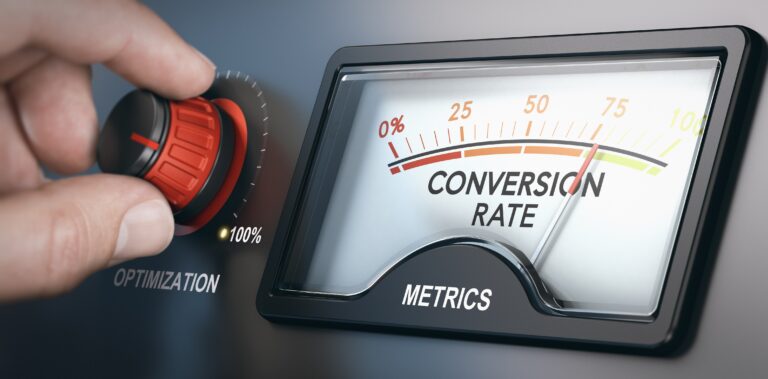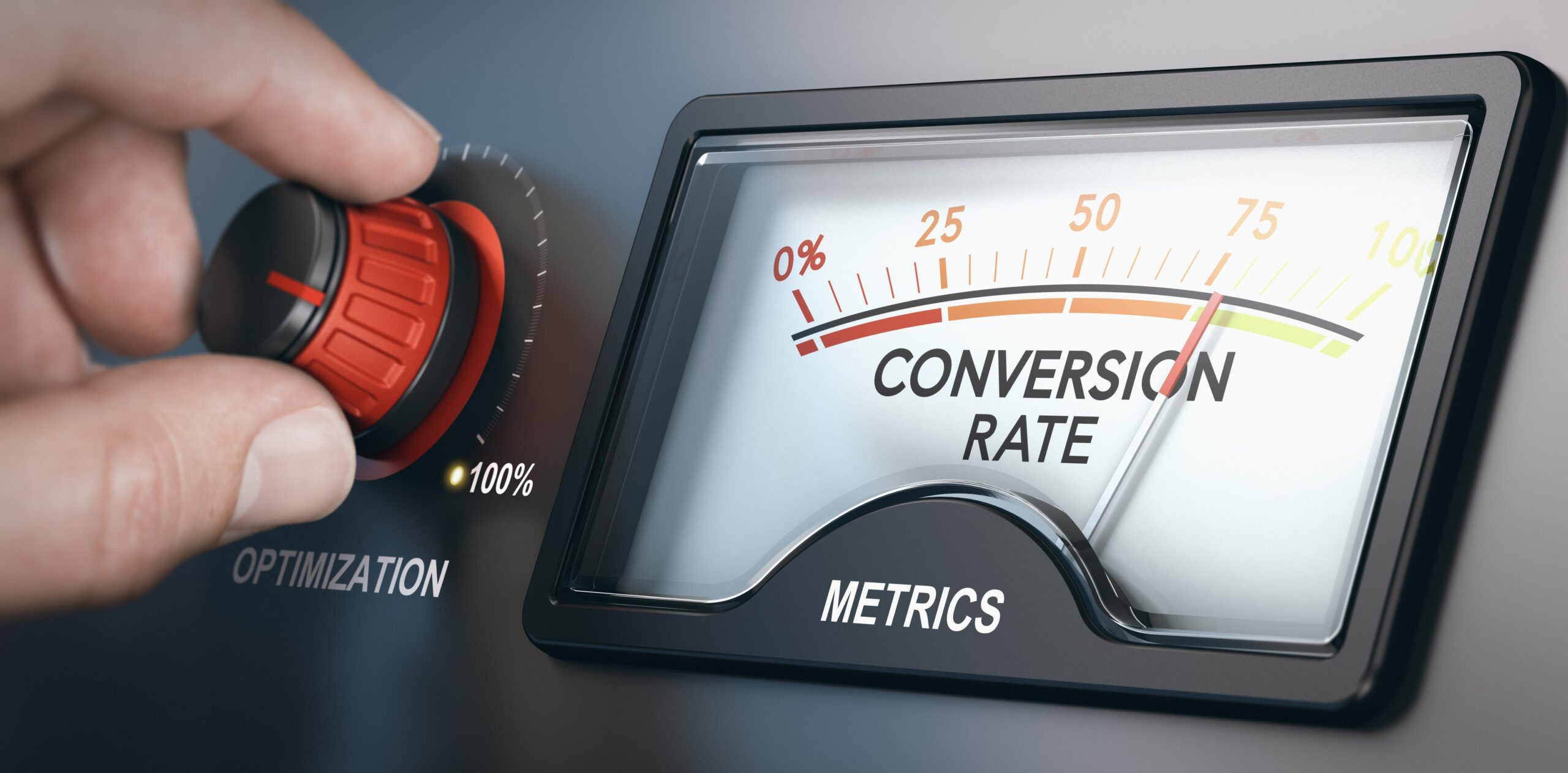Your landing page is a crucial component of your marketing campaign. It serves as the gateway to converting visitors into leads or customers. However, achieving high conversion rates on your landing pages is not easy. It requires careful planning, optimization, and continuous improvement.
These key strategies will help you improve your landing page conversion rates and drive more conversions.
What is a Landing Page Conversion Rate?
The landing page conversion rate measures the percentage of visitors who complete a desired action on your landing page, such as purchasing, signing up for a newsletter, or completing a download. A high conversion rate indicates that your landing page effectively convinces visitors to take the desired action, while a low conversion rate may indicate issues with your messaging or design.
How is the Landing Page Conversion Rate Calculated?
The landing page conversion rate is calculated by dividing the total number of conversions by the total number of visitors to your landing page and then multiplying by 100%. Depending on your reporting preferences, this metric can be measured over different time periods, such as monthly or quarterly. Your website analytics tool should automatically calculate this metric for you.
What’s a Good Landing Page Conversion Rate?
A good landing page conversion rate is between 21% and 50%. However, it’s important to note that the ideal conversion rate can vary depending on factors such as industry, target audience, and competitive landscape. Benchmarking your conversion rate against industry standards and striving for continuous improvement is essential.

Why Your Landing Pages Might Not Be Converting
If your landing page conversion rate is below the industry standard, there are several potential factors to consider.
- Poor above-the-fold section: The top section of your landing page is the first thing visitors see. If it is cluttered, overwhelming, or unattractive, visitors may be less inclined to explore the rest of the page.
- Multiple call-to-action buttons: Multiple call-to-action buttons can confuse visitors and make it unclear which action to take. It’s best to have a single, clear call-to-action button and strategically place it throughout the page.
- Irresponsive landing page design: With many visitors accessing landing pages from mobile devices, it’s crucial to ensure that your landing page design is responsive and mobile-friendly. Otherwise, visitors may quickly leave.
- Slow loading times: If your landing page takes too long to load, visitors may become impatient and leave before taking any action. Optimize your page’s loading speed to minimize bounce rates.
- Poor copywriting: Effective copywriting is essential for persuading visitors to take action. Ensure that your copy resonates with your target audience’s pain points and effectively communicates the value of your offering.

Strategies to Improve Landing Page Conversion Rates
Now that we’ve covered the basics let’s explore strategies that can help improve your landing page conversion rates:
- Conduct a Conversion Research Audit: Conduct a thorough conversion research audit to identify potential issues and areas for improvement. This involves diagnosing the probable causes of suboptimal conversion rates through quantitative and qualitative research.
- Understand User Behavior: To optimize your landing page, it’s important to understand how visitors behave and interact with different elements. Analyze session recordings, heatmaps, and user feedback to identify where visitors spend the most time, encounter friction, or engage in rage-clicking. Use this information to make informed design and content decisions.
- Know Your Target Audience: Creating landing pages without a clear understanding of your target audience is a recipe for failure. Take the time to research and understand your potential customers, their needs, pain points, and motivations. This will enable you to create personalized experiences that resonate with your audience and guide them through the buyer’s journey.
- Craft Compelling Copy: Effective copywriting is essential for engaging visitors and convincing them to act. Use language that speaks directly to your audience and addresses their pain points. Craft clear, compelling headlines and supporting copy that communicates the value of your offering. Experiment with different messaging and use A/B testing to determine the most effective copy.
- Deliver Value: Ensure that your landing page provides clear and tangible value so visitors feel they are getting something of worth in exchange for their actions. This value proposition should be highlighted prominently on your landing page.
- Optimize Above-the-Fold Section: The above-the-fold section of your landing page plays a crucial role in capturing visitors’ attention and encouraging them to explore further. Use this section to communicate your value proposition and entice visitors to scroll down. Keep the messaging concise, compelling, and visually appealing to make a strong first impression.
- Write Headlines that Evoke Emotion: Craft headlines that resonate with your audience’s emotions and capture their attention. Use emotional triggers that align with your value proposition and address your target audience’s pain points. Experiment with different headline variations and test their impact on conversion rates.
- Create a Clear Flow in Your Copy: Ensure that your landing page copy flows logically and guides visitors through the information in a structured manner. Use subheadings, bullet points, and short paragraphs to break up the text and make it easier to read and comprehend. Use persuasive language to guide visitors from one section to the next and ultimately to your call to action.
- Address User Intent Quickly: Capture visitors’ attention and address their intent quickly. Communicate the purpose of your landing page and how it can fulfill visitors’ needs or solve their problems. Highlight key benefits and features early on to keep visitors engaged and interested.
- Utilize Relevant Videos: Incorporate videos that showcase your product or service in action. Videos can be highly engaging and help visitors visualize themselves using your offering. Use videos strategically to demonstrate key features, benefits, or customer testimonials that can persuade visitors to convert.
- Add Trust Signals: Include trust signals on your landing page to build credibility and trust with visitors. This can include customer testimonials, reviews, endorsements, security badges, or industry certifications. Trust signals help alleviate concerns and increase confidence in your offering.
- Minimize Distractions: Remove any unnecessary distractions that may divert visitors’ attention from your call to action. Eliminate excessive navigation menus, links, or other elements that may lead visitors to navigate away from your landing page. Keep the focus on your conversion goal and create a seamless user experience.
- Craft a Strong and Compelling Call to Action (CTA): Your call to action is the most critical element of your landing page. Craft a clear, compelling, and action-oriented CTA that entices visitors to take the desired action. Use contrasting colors, persuasive language, and a prominent placement to draw attention to your CTA.
- Monitor On-Site Behavior: Track and analyze visitor behavior on your landing page to gain insights into how they interact with different elements. Use heatmaps, click maps, and scroll maps to identify areas of interest or friction. This data can help you make informed design decisions and optimize your landing page for better conversion rates.
- Personalize Your Landing Page: Use the data you’ve collected from your audience to personalize your landing page experience. Tailor your messaging, offers, or design elements to specific segments or personas. Personalization can create a more engaging and relevant experience, increasing the likelihood of conversion.
- Optimize for Mobile Devices: Given the increasing number of users accessing websites from mobile devices, optimizing your landing page for mobile responsiveness is crucial. Ensure your landing page is easy to navigate, read, and interact with on smaller screens. Use responsive design techniques and test your landing page on various mobile devices to ensure a seamless experience.
- Continuously Test and Improve: Optimizing your landing page is an ongoing process. Continuously test different elements, monitor performance metrics, and gather user feedback to identify areas for improvement. Use data-driven insights to make informed decisions and implement iterative changes to increase conversion rates.
Contact Bake More Pies
Improving your landing page conversion rates requires strategic planning, optimization, and continuous improvement. Implementing these strategies can significantly improve your landing page conversion rates. With a data-driven approach and a focus on user experience, you can create landing pages that convert visitors into customers.
If you need expert guidance or assistance in optimizing your landing pages for maximum impact, contact Bake More Pies. Our expertise and tailored solutions can help you succeed in your online endeavors. Contact us today to learn more and embark on the journey towards heightened conversion rates and increased business growth.




